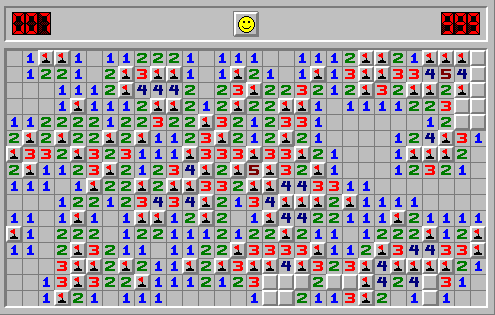There are four regions of unknown tiles. Call the three at the bottom A (size 5), B (size 2), C (size 2) from left to right, and the one at top right D.
Region C
contains exactly one mine. It can go in either square. Nothing we can see can possibly distinguish between the two possibilities.
Regions A and B
are close enough to interact. The possibilities for these regions are (case-splitting on what happens in region B):
! ! 4 ! 3 2 3 !
3 . . ! 2 ! !
1 . . 2 1 1 3 !
and
! ! 4 ! 3 2 3 !
3 . . 2 ! !
1 . . 2 1 1 3 !
where the latter can now be finished off by noting that the 4 needs two more mines adjacent to it:
! ! 4 ! 3 2 3 !
3 ! ! 2 ! !
1 ! 2 1 1 3 !
while the former possibility splits two ways:
! ! 4 ! 3 2 3 !
3 ! ! 2 ! !
1 ! 2 1 1 3 !
and
! ! 4 ! 3 2 3 !
3 ! ! 2 ! !
1 ! 2 1 1 3 !
All of these put 3 mines in region A and 1 in region B.
So now region D
must contain 7-(3+1+1) = 2 mines. The three squares at top right have to contain exactly one (because of the 4); the two at bottom have to contain exactly 1 (because of the 1); so the remaining two squares are clear. Now there is only one place to put the extra mine needed by the 3, namely to its southeast.
At this point we have the following unresolvable unknowns:
Regions A and B: the three possibilities above. Region C: the two possibilities above. Region D, top right: exactly one of those three cells has a mine in it.
To be more explicit about what is guaranteed:
the only guaranteed cells are in region D. In the 2x2 square at the bottom of that region, there is a mine in its southwest corner but not in any of the other three squares.

